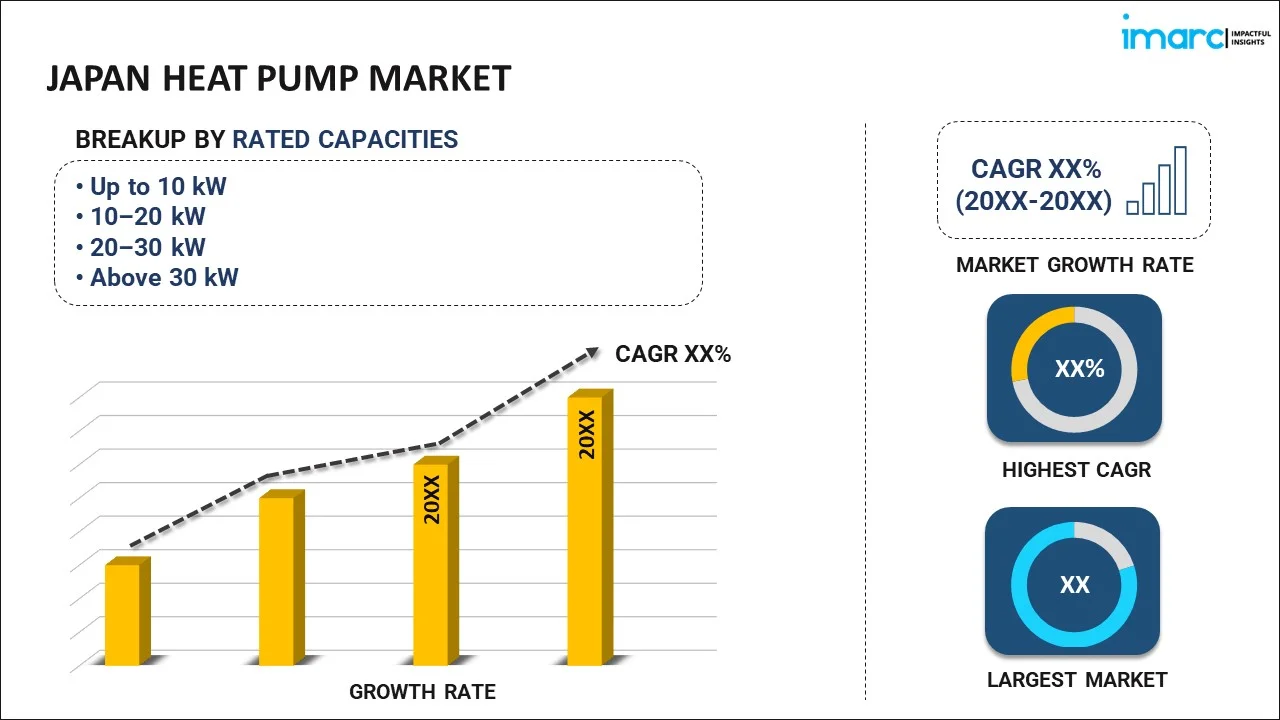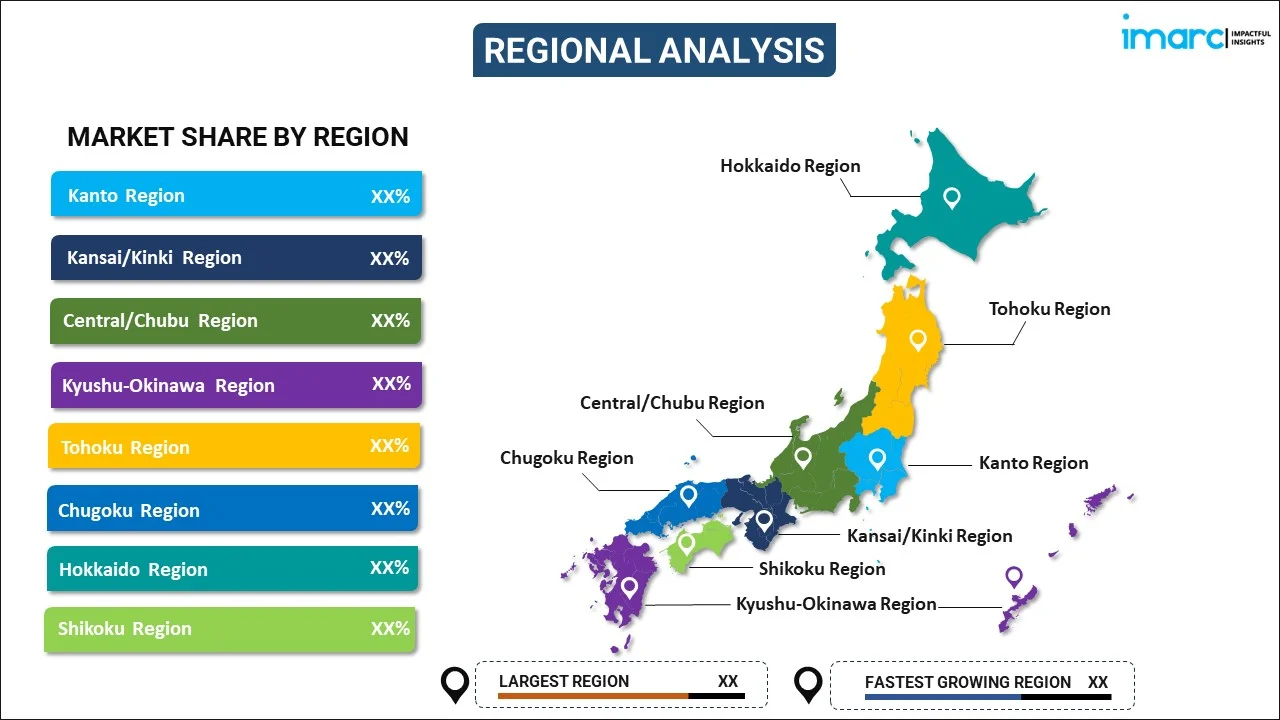
Japan Heat Pump Market Report by Rated Capacity (Up to 10 kW, 10–20 kW, 20–30 kW, Above 30 kW), Product Type (Air Source Heat Pump, Ground Source Heat Pump, Water Source Heat Pump, Exhaust Air Heat Pump, and Others), End Use Sector (Residential, Commercial, Hospitality, Retail, Education, Food and Beverage, Paper and Pulp, Chemicals and Petrochemicals, and Others), and Region 2025-2033
Market Overview:
Japan heat pump market size reached USD 3.8 Billion in 2024. Looking forward, IMARC Group expects the market to reach USD 8.3 Billion by 2033, exhibiting a growth rate (CAGR) of 8.55% during 2025-2033. The increasing urban populations and the rising demand for efficient heating and cooling solutions in residential and commercial buildings is primarily driving the market.
|
Report Attribute
|
Key Statistics
|
|---|---|
|
Base Year
|
2024 |
|
Forecast Years
|
2025-2033 |
|
Historical Years
|
2019-2024
|
| Market Size in 2024 | USD 3.8 Billion |
| Market Forecast in 2033 | USD 8.3 Billion |
| Market Growth Rate (2025-2033) | 8.55% |
A heat pump is a versatile heating and cooling system that efficiently transfers heat from one location to another. It operates by using a small amount of energy to move heat from a low-temperature source to a high-temperature destination, making it an energy-efficient option for both heating and cooling. In heating mode, a heat pump extracts heat from the outdoor air or the ground and transfers it indoors to warm a building. This process is reversed in cooling mode, where it removes heat from indoors and releases it outside, effectively cooling the indoor space. Heat pumps can be highly efficient because they don't generate heat directly but instead move it, making them environmentally friendly and cost-effective in moderate climates. Heat pumps come in various types, including air-source and ground-source (geothermal) systems. They offer energy savings and reduce greenhouse gas emissions compared to traditional heating and cooling systems like furnaces and air conditioners.
Japan Heat Pump Market Trends:
The heat pump market in Japan is experiencing robust growth due to several interconnected drivers. Firstly, increasing concerns about environmental sustainability have driven the adoption of heat pumps. These energy-efficient systems provide both heating and cooling, reducing greenhouse gas emissions by leveraging renewable energy sources like geothermal and solar power. Moreover, stringent government regulations and incentives aimed at reducing carbon footprints have incentivized consumers and businesses to invest in heat pump technology. Furthermore, the rising cost of traditional heating and cooling systems has pushed consumers to seek more cost-effective alternatives. Heat pumps offer significant long-term savings by harnessing ambient heat from the environment and transferring it into buildings for heating during winter or expelling heat during summer. This financial incentive has contributed to the growing popularity of heat pumps. Additionally, technological innovations, such as variable-speed compressors, smart thermostats, and improved refrigerants, which can enhance the performance and convenience of heat pumps, making them an attractive choice for modern consumers, are expected to drive the market in Japan.
Japan Heat Pump Market Segmentation:
IMARC Group provides an analysis of the key trends in each segment of the market, along with forecasts at the country level for 2025-2033. Our report has categorized the market based on rated capacity, product type, and end use sector.
Rated Capacity Insights:

- Up to 10 kW
- 10–20 kW
- 20–30 kW
- Above 30 kW
The report has provided a detailed breakup and analysis of the market based on the rated capacity. This includes up to 10 kw, 10–20 kw, 20–30 kw, and above 30 kw.
Product Type Insights:
- Air Source Heat Pump
- Ground Source Heat Pump
- Water Source Heat Pump
- Exhaust Air Heat Pump
- Others
A detailed breakup and analysis of the market based on the product type have also been provided in the report. This includes air source heat pump, ground source heat pump, water source heat pump, exhaust air heat pump, and others.
End Use Sector Insights:
- Residential
- Commercial
- Hospitality
- Retail
- Education
- Food and Beverage
- Paper and Pulp
- Chemicals and Petrochemicals
- Others
The report has provided a detailed breakup and analysis of the market based on the end use sector. This includes residential, commercial, hospitality, retail, education, food and beverage, paper and pulp, chemicals and petrochemicals, and others.
Regional Insights:

- Kanto Region
- Kansai/Kinki Region
- Central/ Chubu Region
- Kyushu-Okinawa Region
- Tohoku Region
- Chugoku Region
- Hokkaido Region
- Shikoku Region
The report has also provided a comprehensive analysis of all the major regional markets, which include Kanto Region, Kansai/Kinki Region, Central/ Chubu Region, Kyushu-Okinawa Region, Tohoku Region, Chugoku Region, Hokkaido Region, and Shikoku Region.
Competitive Landscape:
The market research report has also provided a comprehensive analysis of the competitive landscape in the market. Competitive analysis such as market structure, key player positioning, top winning strategies, competitive dashboard, and company evaluation quadrant has been covered in the report. Also, detailed profiles of all major companies have been provided.
Japan Heat Pump Market Report Coverage:
| Report Features | Details |
|---|---|
| Base Year of the Analysis | 2024 |
| Historical Period | 2019-2024 |
| Forecast Period | 2025-2033 |
| Units | Billion USD |
| Scope of the Report | Exploration of Historical Trends and Market Outlook, Industry Catalysts and Challenges, Segment-Wise Historical and Future Market Assessment:
|
| Rated Capacities Covered | Up to 10 kW, 10–20 kW, 20–30 kW, Above 30 kW |
| Product Types Covered | Air Source Heat Pump, Ground Source Heat Pump, Water Source Heat Pump, Exhaust Air Heat Pump, Others |
| End Use Sectors Covered | Residential, Commercial, Hospitality, Retail, Education, Food and Beverage, Paper and Pulp, Chemicals and Petrochemicals, Others |
| Regions Covered | Kanto Region, Kansai/Kinki Region, Central/ Chubu Region, Kyushu-Okinawa Region, Tohoku Region, Chugoku Region, Hokkaido Region, Shikoku Region |
| Customization Scope | 10% Free Customization |
| Post-Sale Analyst Support | 10-12 Weeks |
| Delivery Format | PDF and Excel through Email (We can also provide the editable version of the report in PPT/Word format on special request) |
Key Questions Answered in This Report:
- How has the Japan heat pump market performed so far and how will it perform in the coming years?
- What has been the impact of COVID-19 on the Japan heat pump market?
- What is the breakup of the Japan heat pump market on the basis of rated capacity?
- What is the breakup of the Japan heat pump market on the basis of product type?
- What is the breakup of the Japan heat pump market on the basis of end use sector?
- What are the various stages in the value chain of the Japan heat pump market?
- What are the key driving factors and challenges in the Japan heat pump?
- What is the structure of the Japan heat pump market and who are the key players?
- What is the degree of competition in the Japan heat pump market?
Key Benefits for Stakeholders:
- IMARC’s industry report offers a comprehensive quantitative analysis of various market segments, historical and current market trends, market forecasts, and dynamics of the Japan heat pump market from 2019-2033.
- The research report provides the latest information on the market drivers, challenges, and opportunities in the Japan heat pump market.
- Porter's five forces analysis assist stakeholders in assessing the impact of new entrants, competitive rivalry, supplier power, buyer power, and the threat of substitution. It helps stakeholders to analyze the level of competition within the Japan heat pump industry and its attractiveness.
- Competitive landscape allows stakeholders to understand their competitive environment and provides an insight into the current positions of key players in the market.
Need more help?
- Speak to our experienced analysts for insights on the current market scenarios.
- Include additional segments and countries to customize the report as per your requirement.
- Gain an unparalleled competitive advantage in your domain by understanding how to utilize the report and positively impacting your operations and revenue.
- For further assistance, please connect with our analysts.
 Inquire Before Buying
Inquire Before Buying
 Speak to an Analyst
Speak to an Analyst
 Request Brochure
Request Brochure
 Request Customization
Request Customization




.webp)




.webp)












